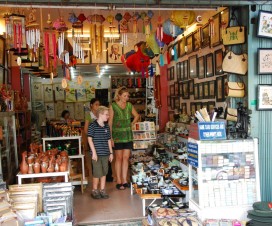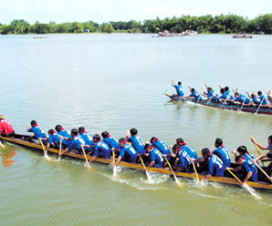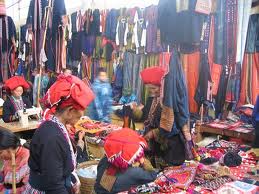Lay down beside the Buddha
On top of Ta Cu — a mountainous plateau accessed by an Austrian cablecar system 1.6 miles long, and 505 meters high — resides the region’s renowned recumbent Buddha. Some 49m long and 10m high, this reclining Buddha is reputed to be the largest in SE Asia. An additional climb through woods droning with cicadas leads you to the fissured and graffiti-splattered Buddha, a cement statue whose serenity and gravitas still manages to shine through, even with forest growth encroaching from all quarters.
Ride the Wind
Who says Charlie don’t surf. Okay, the breaks in Phan Thiet might not satisfy Lieutenant Colonel Bill Kilgore, Robert Duvall’s surf-obsessed character in Apocalypse Now. But this perch on the South China Sea is supremely windy, which has proved the draw for in-the-know adventure sport mavens who make regular pilgrimages here for killer wind- and kite-surfing. Pascal Lefebvre, owner of Jibe’s Beach Club — one of a dozen establishments which can make this experience happen for you — says that Phan Thiet’s popularity is due to the quality of its wind, usually between 20-25 knots during the season, and sometimes as high as 40. “It’s nearly guaranteed every day of the season,” he said. “Great wind and warm water.”
Hit the Road
Unlike traffic-choked Saigon, this part of Binh Thuan Province is a motorbiker’s dream. While most moped-enabled tourists are drawn north of Phan Thiet (to the famed Red Sands of Mui Ne), the coastal road leading south is, if anything, even more alluring. Great swathes of empty sand back onto quaint Vietnamese fishing villages untouched by the hand of development. Rent a motorbike from a local for a few hours (about $5) and head south to Ke Ga Lighthouse. Once past the small downtown of Phan Thiet, you’ll feel as though you’ve got the road all to yourself — and the road is never more than 50 yards from the ocean. Note the secluded resorts along that stretch that seem like ghost towns but are actually great places to stop and have a drink with a view.
Eat & Drink
Quan Bo Ke — Situated at the north end of the Mui Ne strip this al-fresco joint offers some of the cheapest and best seafood in town. Lobsters go down well with the Russian tourists who flock here, but a better bet are the generous platters of grilled scallops with spring onions and peanuts – a steal at around VND90, 000 or $5 a pop.
Joe’s The Art Cafe — Strangely bohemian for a 24-hour bar in an Asian seaside resort, Joe’s offers an imaginative menu, a decent wine list and nightly live music. Perfect for a sandwich or snack after a night out. It also shows movies, sports comfy couches, and stays open till the wee hours of morning.
Cay Bang — Get into some seafood here at the south end of Mui Ne’s strip. Right on the water, it’s popular among locals and tourists alike and offers the rare (and raw) experience of picking your own fish. Upon arrival, you are escorted into a room/garage full of dozens of tanks, swimming with squid, rockfish, grouper, etc) You can tell them to fry it, steam it, grill it, whatever.
Shree Ganesh — Run by the same crew responsible for Saigon’s popular Ganesh restaurant, this particular spice emporium offers a flawless selection of north and south Indian dishes.
![]() Three more fine venues on the strip in Mui Ne: Sankara Beach Bar & Restaurant, The Indian Restaurant, and Mia. For drinks in a more upscale setting, hard to beat The Sailing Club.
Three more fine venues on the strip in Mui Ne: Sankara Beach Bar & Restaurant, The Indian Restaurant, and Mia. For drinks in a more upscale setting, hard to beat The Sailing Club.
Visit Van Thuy Tu Temple
Two hundred years ago, Van Thuy Tu had three separate repositories of whale skeletons. Today, the Temple site is famous mainly as home to Ong Nam Hai, a 100-foot whale skeleton moved inside, in tact, in 1893. The actually found it washed ashore in 1890, and buried the whale in a spot close to the ocean. After three years, the body eroded, they dug up the skeleton and built a temple for it. They still keep more than 100 skeletons here, as with tradition, still burying the whale where they found them or in a sandy cemetery beside the temple — thus offering respectful offerings to the spirits who look after fishermen and bring the bountiful catch. The plants in the cemetery are grown in pots, so the root systems don’t bind up the soil, making exhumation more difficult.
Behold, Bamboo Basket Boats
At night, gazing out onto the East Sea, lines of illuminated squid boats bob gently on the horizon. During the day, the bamboo basket coracle is the more familiar sight — here and all along the south central coast of Vietnam. It takes about a week to weave the strands of a basket boat and seal the bamboo lattice with a pitch derived from the dau trai tree. The boats sell for about 400,000 dong, or $27 each. Fishermen frequently make boats in the grounds of the Van Thuy Tu Temple, and surrounding streets, but they are ubiquitous all along the beaches of Binh Thuan Province. Fishermen propel these boats by churning a single oar, like a milkmaid at butter.
Check out the Cham Towers
The Cham people are thought to have arrived on these shores from the island of Borneo and, at its 9th century peak, the Cham culture controlled coastal lands from Hue in central Vietnam all the way south to the Mekong Delta. The Cham Kingdom fell before the encroaching Vietnamese in the 16th century, but some 100,000 ethnic Chams still reside in Vietnam, and they are particularly prominent in Phan Thiet/Mui Ne. A grouping of impressive Poshanu Cham towers can be found just off the road from Phan Thiet north to Mui Ne. The government repaired and restored these architecturally significant temples from 1990 to 2000. Just beyond the ruins — in a coupling of empires both long gone — are the ruins of a French playboy’s seaside bungalow.
Book resort in mui ne now to get good prices at http://Vietnamhotels.net/




